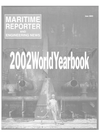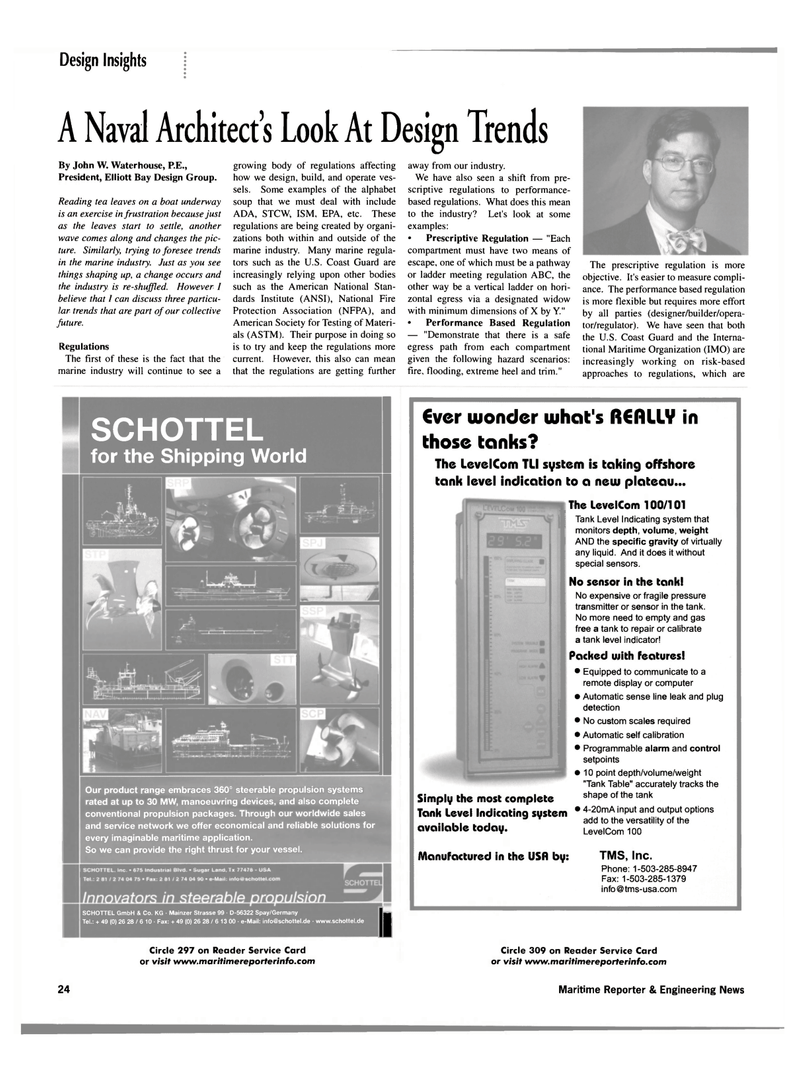
Page 24: of Maritime Reporter Magazine (June 2002)
Read this page in Pdf, Flash or Html5 edition of June 2002 Maritime Reporter Magazine
Design Insights
A Naval Architect's Look At Design Trends
By John W. Waterhouse, P.E.,
President, Elliott Bay Design Group.
Reading tea leaves on a boat underway is an exercise in frustration because just as the leaves start to settle, another wave comes along and changes the pic- ture. Similarly, trying to foresee trends in the marine industry. Just as you see things shaping up, a change occurs and the industry is re-shujfled. However I believe that I can discuss three particu- lar trends that are part of our collective future.
Regulations
The first of these is the fact that the marine industry will continue to see a growing body of regulations affecting how we design, build, and operate ves- sels. Some examples of the alphabet soup that we must deal with include
ADA, STCW, ISM, EPA, etc. These regulations are being created by organi- zations both within and outside of the marine industry. Many marine regula- tors such as the U.S. Coast Guard are increasingly relying upon other bodies such as the American National Stan- dards Institute (ANSI), National Fire
Protection Association (NFPA), and
American Society for Testing of Materi- als (ASTM). Their purpose in doing so is to try and keep the regulations more current. However, this also can mean that the regulations are getting further away from our industry.
We have also seen a shift from pre- scriptive regulations to performance- based regulations. What does this mean to the industry? Let's look at some examples: • Prescriptive Regulation — "Each compartment must have two means of escape, one of which must be a pathway or ladder meeting regulation ABC, the other way be a vertical ladder on hori- zontal egress via a designated widow with minimum dimensions of X by Y." • Performance Based Regulation — "Demonstrate that there is a safe egress path from each compartment given the following hazard scenarios: fire, flooding, extreme heel and trim."
The prescriptive regulation is more objective. It's easier to measure compli- ance. The performance based regulation is more flexible but requires more effort by all parties (designer/builder/opera- tor/regulator). We have seen that both the U.S. Coast Guard and the Interna- tional Maritime Organization (IMO) are increasingly working on risk-based approaches to regulations, which are
SCHOTTEL for the Shipping World
Our product range embraces 360° steerable propulsion systems rated at up to 30 MW, manoeuvring devices, and also complete conventional propulsion packages. Through our worldwide sales and service network we offer economical and reliable solutions for every imaginable maritime application.
So we can provide the right thrust for your vessel.
SCHOTTEL GmbH & Co. KG • Mainzer Strasse 99 • D-56322 Spay/Germany
Tel.: + 49 (0) 26 28 / 6 10 • Fax: + 49 (0) 26 28 / 6 13 00 • e-Mail: [email protected] • www.schottel.de II €ver wonder what's RCflllV in those tanks?
The LevelCom TLI system is taking offshore tank level indication to a new plateau...
The LevelCom 100/101
Tank Level Indicating system that monitors depth, volume, weight
AND the specific gravity of virtually any liquid. And it does it without special sensors.
No sensor in the tank!
No expensive or fragile pressure transmitter or sensor in the tank.
No more need to empty and gas free a tank to repair or calibrate a tank level indicator!
Packed uiith features! • Equipped to communicate to a remote display or computer • Automatic sense line leak and plug detection • No custom scales required • Automatic self calibration • Programmable alarm and control setpoints • 10 point depth/volume/weight "Tank Table" accurately tracks the shape of the tank • 4-20mA input and output options add to the versatility of the
LevelCom 100
TMS, Inc.
Phone: 1-503-285-8947
Fax: 1-503-285-1379 [email protected]
Simply the most complete
Tank Level Indicating system available today.
Manufactured in the USD by:
Circle 297 on Reader Service Card Circle 309 on Reader Service Card or visit www.maritimereporterinfo.com or visit www.maritimereporterinfo.com 24 Maritime Reporter & Engineering News

 23
23

 25
25
